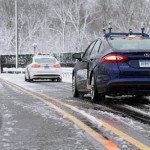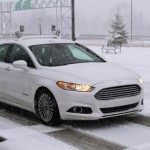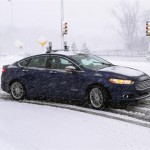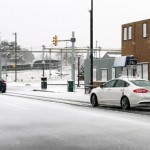DEARBORN, Mich., March 10, 2016 – Driving in snow can be a slippery challenge, with the potential for one blizzardy gust to white-out your field of view – a situation faced by the majority of people in the United States. So if self-driving cars are to become a reality – and they almost certainly will – they must be able to navigate snow-covered roads. In its quest to bring self-driving vehicles to millions of people around the world, Ford reveals six facts about its technology that allows for a car to drive itself in snow.
- Mapping the way: Ford first creates high-resolution 3D maps using LiDAR technology to scan the area its autonomous vehicle will later drive in the snow.
To operate in snow, Ford Fusion Hybrid autonomous vehicles first need to scan the environment to create high-resolution 3D digital maps. By driving the test route in ideal weather, the Ford autonomous vehicle creates highly accurate digital models of the road and surrounding infrastructure using four LiDAR scanners that generate a total of 2.8 million laser points a second. The resulting map then serves as a baseline that’s used to identify the car’s position when driving in autonomous mode. Using the LiDAR sensors to scan the environment in real time, the car can locate itself within the mapped area later, when the road is covered in snow. - Better have an unlimited data plan: Ford’s autonomous vehicles collect and process significantly more mapping data in an hour than the average person uses in mobile-phone data in 10 years.
While mapping their environment, Ford autonomous vehicles collect and process a diverse set of data about the road and surrounding landmarks – signs, buildings, trees and other features. All told, the car collects up to 600 gigabytes per hour, which it uses to create a high-resolution 3D map of the landscape. In the United States, the average subscriber of a cellular data plan uses about 21.6 gigabytes per year, for a 10-year total of 216 gigabytes. - Super smart sensors: Ford uses LiDAR sensors that are so powerful, they can even identify falling snowflakes and raindrops.
Ford’s autonomous vehicles generate so many laser points from the LiDAR sensors that some can even bounce off falling snowflakes or raindrops, returning the false impression that there’s an object in the way. Of course, there’s no need to steer around precipitation, so Ford – working with University of Michigan researchers – created an algorithm that recognizes snow and rain, filtering them out of the car’s vision so it can continue along its path. - Not your average navigation: The way Ford’s autonomous vehicles identify their location is more accurate than GPS.
When you think about vehicle navigation, GPS usually comes to mind. But where current GPS is accurate to just more than 10 yards, autonomous operation requires precise vehicle location. By scanning their environment for landmarks, then comparing that information to the 3D digital maps stored in their databanks, Ford’s autonomous vehicles can precisely locate themselves to within a centimeter. - No need for glasses: Sensor fusion – the combination of data from multiple sensors – plus smart monitoring of sensor health help keep Ford’s autonomous vehicles out of the blind.
In addition to LiDAR sensors, Ford uses cameras and radar to monitor the environment around the vehicle, with the data generated from all of those sensors fused together in a process known as sensor fusion. This process results in robust 360-degree situational awareness. Sensor fusion means that one inactive sensor – perhaps caused by ice, snow, grime or debris buildup on a sensor lens – does not necessarily hinder autonomous driving. Still, Ford autonomous vehicles monitor all LiDAR, camera and radar systems to identify the deterioration of sensor performance, which helps keep sensors in ideal working order. Eventually, the cars might be able to handle ice and grime buildup themselves through self-cleaning or defogging measures. - Look Mom, no hands: The first person behind the wheel of a demonstrated autonomy test in snow is an astrophysics major who never dreamed he’d be in a self-driving car.
Before Wayne Williams joined Ford’s autonomy team, he worked on remote sensing technology on behalf of the federal government. A self-described “geek,” Williams was intrigued by autonomous vehicles. But he never envisioned one day being part of a team working to bring them to reality – let alone being behind the wheel of the auto industry’s first publicly demonstrated autonomous snow test. The mood in the car that day was all business, he recalls, with a coworker monitoring the computing system from the back seat. “Because of the extensive development work, we were confident the car would do exactly what we asked of it,” says Williams. “But it wasn’t until after the test that the achievement began to sink in.”
Ford is the first automaker to publicly demonstrate autonomous vehicle operation in the snow. The company’s winter weather road testing takes place in Michigan, including at Mcity – a 32-acre, real-world driving environment at the University of Michigan. Ford’s testing on this full-scale simulated urban campus is aimed at supporting the company’s mission to learn about and advance the emerging field of autonomous driving.
FORD CONDUCTS INDUSTRY-FIRST SNOW TESTS OF AUTONOMOUS VEHICLES — FURTHER ACCELERATING DEVELOPMENT PROGRAM
DETROIT, Jan. 11, 2016 – Ford is conducting the industry’s first autonomous vehicle tests in snow-covered environments – a major step in the company’s plan to bring fully autonomous vehicles to millions of customers worldwide.
Unlike other major automakers and technology companies, which have tested autonomous vehicle technology only in dry, mostly sunny climates, Ford knows the future of autonomous driving cannot rely on ideal conditions.
“It’s one thing for a car to drive itself in perfect weather,” said Jim McBride, Ford technical leader for autonomous vehicles. “It’s quite another to do so when the car’s sensors can’t see the road because it’s covered in snow. Weather isn’t perfect, and that’s why we’re testing autonomous vehicles in wintry conditions – for the roughly 70 percent of U.S. residents who live in snowy regions.”
Ford’s winter weather testing takes place in Michigan, including at Mcity – a 32-acre, full-scale simulated real-world urban environment at the University of Michigan.
Fully autonomous driving can’t rely on GPS, which is accurate only to several yards – not enough to localize or identify the position of the vehicle. And it’s key that an autonomous vehicle knows its precise location, not just within a city or on a road, but in its actual driving lane – a variation of a few inches makes a big difference.
LiDAR, on the other hand, is much more accurate than GPS – identifying the Fusion Hybrid’s lane location right down to the centimeter. LiDAR emits short pulses of laser light to precisely allow the vehicle to create a real-time, high-definition 3D image of what’s around it.
In ideal weather, LiDAR is the most efficient means of gathering important information and metadata – underlying information about the data itself – from the surrounding environment, sensing nearby objects and using cues to determine the best driving path. But on snow-covered roads or in high-density traffic, LiDAR and other sensors such as cameras can’t see the road. This is also the case when the sensor lens is covered by snow, grime or debris.
Undaunted by this challenge, Ford and University of Michigan technologists began collaborating toward a solution that would allow an autonomous vehicle to see on a snow-covered road.
How snow autonomy works
To navigate snowy roads, Ford autonomous vehicles are equipped with high-resolution 3D maps – complete with information about the road and what’s above it, including road markings, signs, geography, landmarks and topography.
“Maps developed by other companies don’t always work in snow-covered landscapes,” said Ryan Eustice, associate professor at University of Michigan college of engineering. “The maps we created with Ford contain useful information about the 3D environment around the car, allowing the vehicle to localize even with a blanket of snow covering the ground.”
An autonomous vehicle creates the maps while driving the test environment in favorable weather, with technologies automatically annotating features like traffic signs, trees and buildings. When the vehicle can’t see the ground, it detects above-ground landmarks to pinpoint itself on the map, and then subsequently uses the map to drive successfully in inclement conditions.
“The vehicle’s normal safety systems, like electronic stability control and traction control, which often are used on slippery winter roads, work in unison with the autonomous driving software,” said McBride. “We eventually want our autonomous vehicles to detect deteriorating conditions, decide whether it’s safe to keep driving, and if so, for how long.”
A pioneer in autonomy
Winter driving still presents a host of challenges, but Ford’s testing marks an important achievement on the road to autonomous driving. That road goes back roughly a decade, to the first-generation autonomous vehicle from Ford – a LiDAR-equipped F-250 Super Duty.
In 2013, Ford launched its second-generation autonomous vehicle platform, a Fusion Hybrid sedan using more advanced LiDAR sensors. This past summer, Ford transitioned its fully autonomous vehicle development program from the research to advanced engineering phase, the second of three phases before entering production.
Earlier this month, Ford announced it is taking the next step – tripling its fully autonomous development fleet to 30 vehicles being tested on roads and test tracks in California, Arizona and Michigan. This makes the company’s fully autonomous vehicle fleet the largest of all automakers. These third-generation autonomous vehicles continue to be based on a Fusion Hybrid sedan now featuring the first auto-specific LiDAR sensor capable of handling different driving scenarios – thanks in part to its longer range of around 200 meters.
Building on more than a decade of Ford autonomous vehicle research, this advancement is a key element ofFord Smart Mobility – the plan to take Ford to the next level in connectivity, mobility, autonomous vehicles, the customer experience, and data and analytics.




